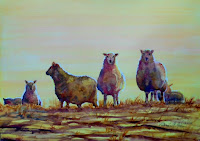
Often when a bunch of artists
get together for a conversation, the question arises – “Well, what is Art
anyway?” Each person in the group tries
to clarify what Art is from his or her own perspective. Rarely do they agree on a clear
definition. One dictionary defines Art
as “the expression or application of human creative skill and imagination,
typically in a visual form such as painting or sculpture, producing works to be
appreciated primarily for their beauty or emotional power”. Yet how many times have we looked at a
painting and had an adverse reaction to it’s graphic ugliness.
How many times have we looked at a painting of lines on a canvas and
thought – "what’s so special about this piece that a museum paid thousands of
dollars for it?" Has this always been the
case? Back in the day, the definition of
Art was much clearer as there were consistent rules by which artists
created. Those who broke the rules were
rejected; denied opportunities to show and sell their work. Artists made choices to stay securely within
the fold or to become part of the avant garde and alter the meaning of Art.
What we can probably agree on
about Art today is that it usually sparks an emotional response of some
sort. The meaning of a work of art for
both the painter and the viewer varies, depending on what experiences they’ve
had in their own lives. Art itself is a component of our culture, influenced by
the events, economics and social movements of it’s time and place. Most significantly, Art is always changing
and is too fluid to pin down in any one simple definition. It certainly doesn’t hurt each of us as artists to consider what Art is, but the
question we will probably ask ourselves is not what is Art but how will I
interpret Art today?



No comments:
Post a Comment